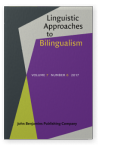Commentary
Developmental continuity in morphosyntactic attrition
References
References
Aissen, J.
(
2003)
Differential object marking: iconicity vs. economy.
Natural Language and Linguistic Theory, 21(3), 435–448.


Chamorro, G., Sturt, P., & Sorace, A.
(
2016)
Selectivity in L1 Attrition: Differential Object Marking in Spanish Near-Native Speakers of English.
Journal of Psycholinguistic Research, 45(3), 697–715.

.

Grüter, T., Lew-Williams, C., & Fernald, A.
(
2012)
Grammatical gender in L2: A production or a real-time processing problem? Second Language Research, 28(2), 191–215.


Guijarro Fuentes, P.
(
2012)
The acquisition of interpretable features in L2 Spanish: Personal a
.
Bilingualism, Language and Cognition, 15(4), 701–720.


Hopp, H., & León Arriaga, M.
(
2016)
Structural and inherent case in the non-native processing of Spanish: Constraints on inflectional variability.
Second Language Research, 32(1), 75–108.


Kim, K., O’Grady, W., & Schwartz, B.
Montrul, S.
(
2010)
How similar are L2 learners and heritage speakers? Spanish clitics and word order.
Applied Psycholinguistics, 31(1), 167–207.


Montrul, S.
(
2014)
Searching for the roots of structural changes in the Spanish of the United States.
Lingua, 151(B), 177–196.


Montrul, S., & Sánchez-Walker, N.
(
2013)
Differential object marking in child and adult Spanish heritage speakers.
Language Acquisition, 20(2), 109–132.


Montrul, S., Foote, R., & Perpiñán, S.
(
2008)
Gender agreement in adult second language learners and Spanish heritage speakers: The effects of age and context of acquisition.
Language Learning, 58(3), 503–553.


Montrul, S., Bhatt, R., & Girju, R.
(
2015)
Differential Object Marking in Spanish, Hindi and Romanian as heritage languages.
Language, 91(3), 564–610.


Montrul, S. & Gürel, A.
(
2015)
The acquisition of Differential Object Marking in Spanish by Turkish speakers. In
T. Judy &
S. Perpiñán (eds.),
The Acquisition of Spanish by speakers of less commonly studies languages (pp. 281–308). Amsterdam: John Benjamins.

Papadopoulou, D., Varlokosta, S., Spyropoulos, V., Kaili, H., Prokou, S. & Revithiadou, A.
(
2010)
Case morphology and word order in second language Turkish: Evidence from Greek learners Second Language Research
, 27(2), 173–204.


Seliger, H. & Vago, R.
(
1991)
The study of first language attrition: An overview. In
H. Seliger &
R. Vago (eds.),
First language attrition (pp. 17–30). Cambridge: CUP.


Cited by
Cited by 1 other publications
Montrul, Silvina
2020.
Attrition, addition, and age.
Second Language Research 36:2
► pp. 213 ff.

This list is based on CrossRef data as of 3 april 2024. Please note that it may not be complete. Sources presented here have been supplied by the respective publishers.
Any errors therein should be reported to them.
